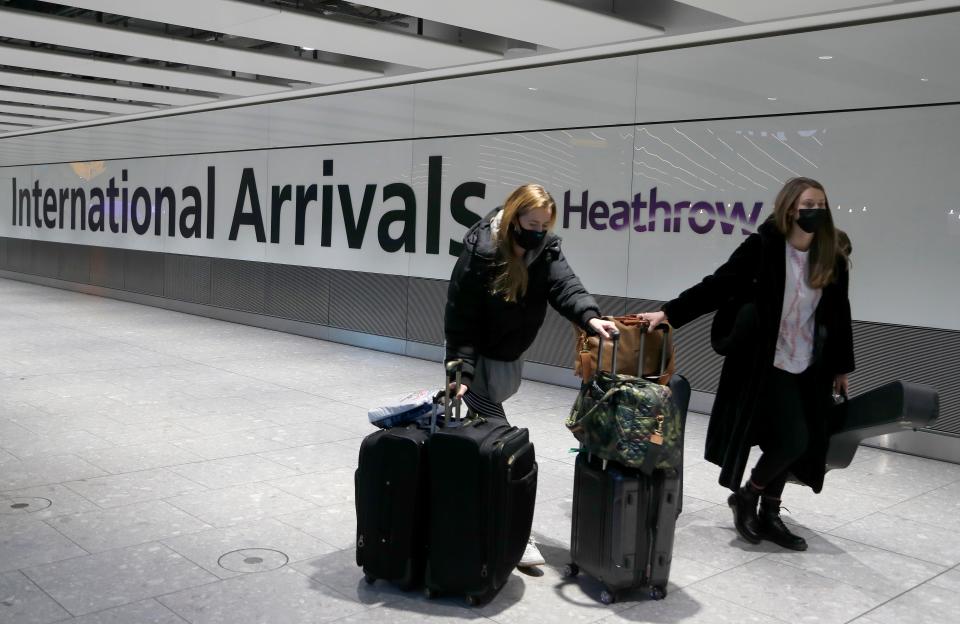Which countries are on the red list? Full list

Arrivals from certain countries will have to stay at designated quarantine hotels
(AP)From 17 May, international travel was given the official go-ahead in England by the Global Travel Taskforce, subject to a traffic light system.
The new rules mean each country or region will be classified as red, amber or green. There will also be a “green watchlist”, which is a measure that the government will use as a way to identify the countries most at risk of moving from green to amber.
But which countries are high risk and what are the rules? Here’s everything you need to know.
Which countries are high risk?
The government has mandated hotel quarantine plans for Britons returning from high-risk or “red list” countries to stop new coronavirus variants entering England.
According to transport secretary Grant Shapps, red list countries are “those which should not be visited except in the most extreme of circumstances”.
The countries are mainly located in South America and southern Africa. Here’s the full list.
Afghanistan
Angola
Argentina
Bahrain
Bangladesh
Bolivia
Botswana
Brazil
Burundi
Cape Verde
Chile
Colombia
Costa Rica
Democratic Republic of Congo
Ecuador
Egypt
Eswatini
Ethiopia
French Guiana
Guyana
India
Kenya
Lesotho
Malawi
Maldives
Mozambique
Namibia
Nepal
Oman
Pakistan
Panama
Paraguay
Peru
Philippines
Qatar
Rwanda
Seychelles
Somalia
South Africa
Sri Lanka
Sudan
Suriname
Tanzania
Trinidad & Tobago
Turkey
Uruguay
United Arab Emirates
Venezuela
Zambia
Zimbabwe
The list was originally 30 countries long. Additional countries have since been added, and the full list is now comprised of 50 destinations.
Hotel quarantine first came into effect on 15 February.
India was added to the red list on 23 April, over concerns of its new variant; while the Maldives, Turkey and Nepal were added on 7 May.
The most recent additions were Afghanistan, Bahrain, Costa Rica, Egypt, Sri Lanka, Sudan, and Trinidad & Tobago on 3 June.
What determines whether a country is high risk?
As the move to use quarantine hotels is primarily in response to new variants of Covid-19, it’s likely that a country will be deemed “high risk” if one of the new variants has been identified there.
As well as the UK’s own variant, named B.1.1.7, other mutations have been found in South Africa (1.351), Brazil (P.1) and India (B.1.617.2). This last “contains a set of additional mutations that may affect its ability to be recognised by antibodies,” according to the US Centers for Disease Control and Prevention (CDC).
Read more: Who pays for hotel quarantine and how long will it last?
It adds: “These variants seem to spread more easily and quickly than other variants, which may lead to more cases of Covid-19. Currently, there is no evidence that these variants cause more severe illness or increased risk of death.”
According to the second Global Travel Taskforce report, published on 9 April, the key factors in assessing a country’s risk factor will be its rate of infection, the prevalence of variants of concern and the progress of its vaccination programme.
International travel hubs, such as the UAE, are also deemed to be high risk due to the number of passengers catching connecting flights from all over the world.
Where will high risk travellers stay and how will they get there?
According to health secretary Matt Hancock, 16 hotels, with a total of 4,600 rooms, have been contracted. Bath Road, which runs parallel to the runway at London Heathrow airport, has been dubbed “Isolation Row”.
Travellers will be privately “escorted” to their quarantine hotel upon arrival.
Fines of up to £10,000 will apply to arrivals who fails to undergo the stipulated hotel quarantine, while people who misrepresent their travel history on the passenger locator forms face up to 10 years in prison.
Travellers will have to finance the quarantine themselves, at a cost of £1,750 per person for those travelling alone, which includes 10 days' (11 nights') room and board. Additional people in the same hotel room will pay significantly less. The second will pay only £650, with further discounts for children: £325 each. A family of four will pay £3,050.
How long is quarantine?
The current quarantine for all arrivals into the UK is 10 days and 11 nights. This will remain the same for any arrivals from countries on the red list once the traffic light system comes into effect, which will be no earlier than 17 May.
What about all other arrivals?
When the new traffic light system is in place, travellers from countries on the amber list will need to self-isolate for 10 days at home, with the chance of early release in England if you pay for another test after five days.
For travellers returning from countries on the green list, there will be no need to quarantine on return, but a pre-booked post-arrival PCR test will be needed. It must be taken on the day of arrival (“day zero”), the day after or the following day (“day two”).
Read More
UK weather: The latest Met Office forecast
France tightens travel restrictions for UK travellers
‘Heartbreaking to watch’: Britons scramble back from Portugal amid amber list deadline

 Yahoo Finance
Yahoo Finance 
